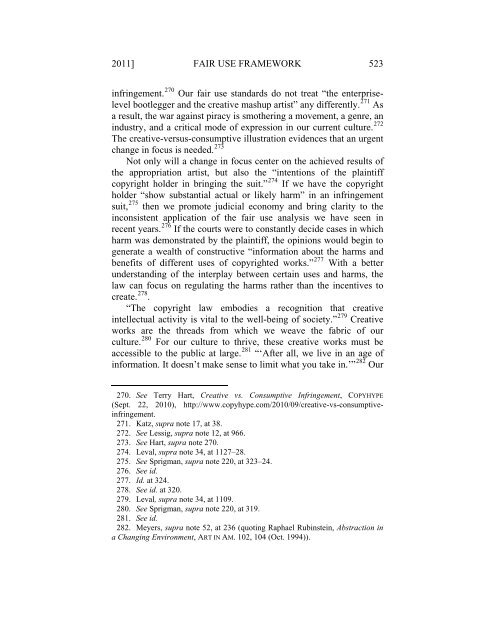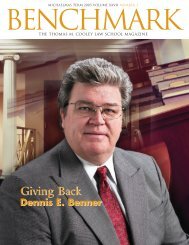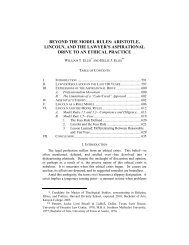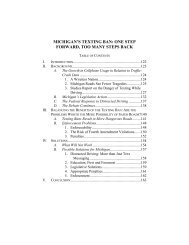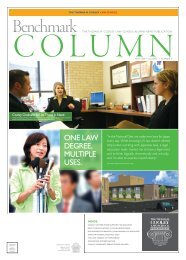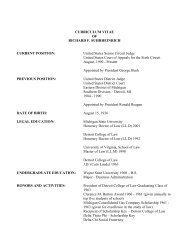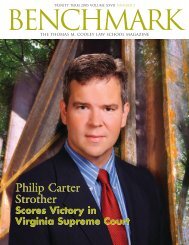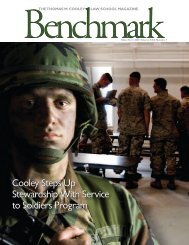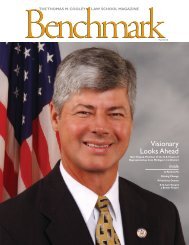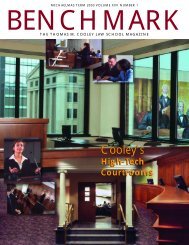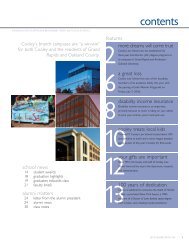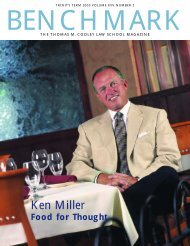Blanch It, Mix It, Mash It - Thomas M. Cooley Law School
Blanch It, Mix It, Mash It - Thomas M. Cooley Law School
Blanch It, Mix It, Mash It - Thomas M. Cooley Law School
Create successful ePaper yourself
Turn your PDF publications into a flip-book with our unique Google optimized e-Paper software.
2011] FAIR USE FRAMEWORK 523<br />
infringement. 270 Our fair use standards do not treat “the enterpriselevel<br />
bootlegger and the creative mashup artist” any differently. 271 As<br />
a result, the war against piracy is smothering a movement, a genre, an<br />
industry, and a critical mode of expression in our current culture. 272<br />
The creative-versus-consumptive illustration evidences that an urgent<br />
change in focus is needed. 273<br />
Not only will a change in focus center on the achieved results of<br />
the appropriation artist, but also the “intentions of the plaintiff<br />
copyright holder in bringing the suit.” 274 If we have the copyright<br />
holder “show substantial actual or likely harm” in an infringement<br />
suit, 275 then we promote judicial economy and bring clarity to the<br />
inconsistent application of the fair use analysis we have seen in<br />
recent years. 276 If the courts were to constantly decide cases in which<br />
harm was demonstrated by the plaintiff, the opinions would begin to<br />
generate a wealth of constructive “information about the harms and<br />
benefits of different uses of copyrighted works.” 277 With a better<br />
understanding of the interplay between certain uses and harms, the<br />
law can focus on regulating the harms rather than the incentives to<br />
create. 278 .<br />
“The copyright law embodies a recognition that creative<br />
intellectual activity is vital to the well-being of society.” 279 Creative<br />
works are the threads from which we weave the fabric of our<br />
culture. 280 For our culture to thrive, these creative works must be<br />
accessible to the public at large. 281 “‘After all, we live in an age of<br />
information. <strong>It</strong> doesn’t make sense to limit what you take in.’” 282 Our<br />
270. See Terry Hart, Creative vs. Consumptive Infringement, COPYHYPE<br />
(Sept. 22, 2010), http://www.copyhype.com/2010/09/creative-vs-consumptiveinfringement.<br />
271. Katz, supra note 17, at 38.<br />
272. See Lessig, supra note 12, at 966.<br />
273. See Hart, supra note 270.<br />
274. Leval, supra note 34, at 1127–28.<br />
275. See Sprigman, supra note 220, at 323–24.<br />
276. See id.<br />
277. Id. at 324.<br />
278. See id. at 320.<br />
279. Leval, supra note 34, at 1109.<br />
280. See Sprigman, supra note 220, at 319.<br />
281. See id.<br />
282. Meyers, supra note 52, at 236 (quoting Raphael Rubinstein, Abstraction in<br />
a Changing Environment, ART IN AM. 102, 104 (Oct. 1994)).


